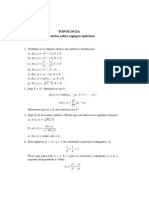Somatrio
Somatrio
Enviado por
PhaelDireitos autorais:
Formatos disponíveis
Somatrio
Somatrio
Enviado por
PhaelDireitos autorais
Formatos disponíveis
Compartilhar este documento
Compartilhar ou incorporar documento
Você considera este documento útil?
Este conteúdo é inapropriado?
Direitos autorais:
Formatos disponíveis
Somatrio
Somatrio
Enviado por
PhaelDireitos autorais:
Formatos disponíveis
Somatório
A soma de n termos pode ser simbolicamente representada por
n
∑x
i =1
i = x1 + x 2 + K + x n
Partes do símbolo:
O n é o último elemento
A instrução para a ser somado
n
∑x
somar
i x é o nome dos termos a
i =1 serem somados
O primeiro elemento i é uma observação
dos termos a serem individual da série
somados
Lê-se: “Somatório de xi, para i variando de 1 a n” ou “soma de xi, para i variando de 1 a
n”.
O símbolo ∑ é a letra grega sigma maiúscula.
Se estamos interessados na soma dos terceiro, quarto, . . .centésimo elementos,
devemos escrever:
100
∑x .
i= 4
i
Propriedades dos somatórios
1. Se cada elemento da série é multiplicado por uma constante, os elementos pode
ser somados, e a soma multiplicada pela constante.
n n
∑ cxi = c ∑ xi
i =1 i =1
2. A soma de uma constante sobre n termos é igual a n vezes a constante.
n
∑ c = nc
i =1
3. O somatório da soma (ou diferença) é igual à soma (ou diferença) de somatórios.
n n n
∑ (x i ± y i ) = ∑ x i ± ∑ y i
i =1 i=1 i =1
Prof. Paulo Fernando Braga Carvalho
Para melhor compreensão das propriedades, veja alguns exemplos:
Variável x: xi=5 x2=3 x3=−2 x4=0
Variável y: y1=2 y2=3 y3=−3 y4=1
Para a 1a propriedade, vamos supor que a constante seja igual a 3, então:
4 4
∑ cx i = c ∑ x i
i =1 i=1
cx1+cx2+cx3+cx4=c(x1+x2+x3+x4)
3 ⋅ 5 + 3 ⋅ 3 + 3 ⋅ ( −2) + 3 ⋅ 0 = 3 ⋅ (5 + 3 + (− 2) + 0 )
18=18
Para a 2a propriedade, vamos supor que a constante seja igual a 3 e n =4, então
4
∑ c = nc
i =1
c+c+c+c=nc
3+3+3+3=4⋅3
12=12
Para a 3a propriedade, temos:
4 4 4
∑ (x i + y i ) = ∑ x i + ∑ y i
i =1 i =1 i =1
(x 1 + y 1 ) + (x 2 + y 2 ) + (x 3 + y 3 ) + (x 4 + y 4 ) = (x 1 + x 2 + x 3 + x 4 ) + (y 1 + y 2 + y 3 + y 4 )
(5+2)+(3+3)+(−2–3)+(0+1)=[5+3+(−2)+0]+[2 + 3 +(−3)+1]
9=9
Quando não houver possibilidade de dúvidas, podemos eliminar os índices. Assim:
n n
∑x e ∑ x 2 podem ser usados, ao invés de ∑ xi e
i =1
∑x
i =1
2
i .
2
n
2
ATENÇÃO: ∑
i =1
x ≠ ∑ x i
2
i
i=1
Somatório duplo:
i j 1 2 3 4
1 5 −2 0 1
2 2 1 0 −2
3 1 2 4 3
3 4
Calcular ∑∑ x ij = [x 11 + x 12 + x 13 + x 14 ] + [x 21 + x 22 + x 23 + x 24 ] + [x 31 + x 32 + x 33 + x 34 ] =
i =1 j=1
[5+(−2)+0+1]+[2+1+0+(−2)]+[1+2+4+3]= 15
Prof. Paulo Fernando Braga Carvalho
Observação: As propriedades vistas anteriormente também são válidas nesses casos.
Produtório
n
∏x
i=1
i = x1 ⋅ x 2 ⋅K ⋅ x n
O n é o último elemento
A instrução para a ser multiplicado
n
∏x
multiplicar
i x é o nome dos termos a
i=1 serem multiplicados
O primeiro elemento i é uma observação
dos termos a serem individual da série
multiplicados
Propriedades dos produtórios:
1. Se cada elemento da série é multiplicado por uma constante, o produto dos termos
ficará multiplicado pela constante elevada ao número de termos do produtório.
n n
∏k ⋅ xi = kn ⋅ ∏ xi
i =1 i=1
2. O produtório do produto é igual ao produto dos produtórios.
n
n n
∏ (x i ⋅ y i ) = ∏ i ⋅ ∏ y i
x
i =1 i=1 i=1
Para melhor compreensão das propriedades, veja alguns exemplos:
Variável x: xi=5 x2=3 x3=−2 x4=1
Variável y: y1=2 y2=3 y3=−3 y4=1
Para a 1a propriedade, vamos considerar que a constante seja igual a 3, então:
4 4
∏k ⋅ xi = k 4 ⋅ ∏ yi
i =1 i=1
(kx1)⋅ (kx2)⋅ (kx3)⋅ (kx4)=k4⋅(x1⋅x2⋅x3⋅x4)
(3⋅5) ⋅(3⋅3)⋅[3⋅(−2)]⋅(3⋅1)=34⋅[5⋅3⋅(−2)⋅1]
−2.430=−2.430
(x1⋅y1)⋅(x2⋅y2) ⋅(x3⋅y3) ⋅(x4⋅y4)=(x1⋅x2⋅x3⋅x4)⋅(y1⋅y2⋅y3⋅y4)
Prof. Paulo Fernando Braga Carvalho
Você também pode gostar
- Resolucao Do Livro ConfiabilidadeDocumento4 páginasResolucao Do Livro ConfiabilidadegabrielAinda não há avaliações
- N1 - Ferramentas Práticas para A InovaçãoDocumento4 páginasN1 - Ferramentas Práticas para A Inovaçãojoseph arthurAinda não há avaliações
- SomatorioProdutorio PDFDocumento5 páginasSomatorioProdutorio PDFDiogo DiasAinda não há avaliações
- Gabarito Prova 1 Turma M1Documento4 páginasGabarito Prova 1 Turma M1Paulo Luis SempeAinda não há avaliações
- Lista 2 SériesDocumento3 páginasLista 2 SériesMarcos EduardoAinda não há avaliações
- Lista 1 GabaritoDocumento2 páginasLista 1 Gabaritopablodepaula29Ainda não há avaliações
- Lista 103213Documento12 páginasLista 103213samuellmillioleAinda não há avaliações
- 5 Medidas de Tendencia CentralDocumento4 páginas5 Medidas de Tendencia Centralyassiminemendes873Ainda não há avaliações
- Resumo e Exercícios CombinatóriaDocumento18 páginasResumo e Exercícios CombinatóriaRafael DiasAinda não há avaliações
- Somatrio PDFDocumento7 páginasSomatrio PDFAdinovamAinda não há avaliações
- Análise Mat - Livro-Texto - Unidade IIDocumento47 páginasAnálise Mat - Livro-Texto - Unidade IIdk.ciencia.computacaoAinda não há avaliações
- UntitledDocumento1 páginaUntitledMATHEUS FORTUNATO DARIOAinda não há avaliações
- Aula 10Documento6 páginasAula 10jose rodrigoAinda não há avaliações
- Ficha 1Documento9 páginasFicha 1tomas fonsecaAinda não há avaliações
- Exercícios Cálculo IIDocumento3 páginasExercícios Cálculo IIAddison VianaAinda não há avaliações
- Exercicio - Contagem e Relaes de RecorrnciaaDocumento5 páginasExercicio - Contagem e Relaes de RecorrnciaaMax WilliamAinda não há avaliações
- Nivel 3 Algebra Aula 3Documento10 páginasNivel 3 Algebra Aula 3Thadeu Augusto Rufino do NascimentoAinda não há avaliações
- Aula1 Calculo IVDocumento6 páginasAula1 Calculo IVGuilhermeGapAinda não há avaliações
- Somatorio e ProdutorioDocumento12 páginasSomatorio e ProdutorioPaulo GabrielAinda não há avaliações
- Top - 7 - Soluções em Séries em Ponto Ordinário - Parte 1Documento8 páginasTop - 7 - Soluções em Séries em Ponto Ordinário - Parte 1pedrortavaresAinda não há avaliações
- Eb101c Gabarito Lista01 Matemática BásicaDocumento6 páginasEb101c Gabarito Lista01 Matemática BásicaJoy ceAinda não há avaliações
- Capitulo005 Introducao Ao Estudo de SeriesDocumento13 páginasCapitulo005 Introducao Ao Estudo de SeriesAllan Sousa SoaresAinda não há avaliações
- FileDocumento4 páginasFileMarcela Sarmento DiasAinda não há avaliações
- Lista2 1cálculoDocumento4 páginasLista2 1cálculoMaria Clara Minafra RezendeAinda não há avaliações
- Calculoc 4 PDFDocumento2 páginasCalculoc 4 PDFJAN cONÇEICÃO DOS SANTOSAinda não há avaliações
- Terceira Avaliação GabaritoDocumento5 páginasTerceira Avaliação GabaritoGiovanna RodriguesAinda não há avaliações
- Apostila QUI148 Agosto 2018Documento33 páginasApostila QUI148 Agosto 2018Eugenio ManuelAinda não há avaliações
- Séries (Somatórios e Produtórios)Documento19 páginasSéries (Somatórios e Produtórios)Manoel SouzaAinda não há avaliações
- Resolução 624 Funo - ExponencialDocumento9 páginasResolução 624 Funo - ExponencialFernando FerreiraAinda não há avaliações
- Identidades - I - TrigonometricasDocumento2 páginasIdentidades - I - Trigonometricasguisouza13715Ainda não há avaliações
- MetodomatDocumento132 páginasMetodomatGabriel Silva SantosAinda não há avaliações
- AM3 17T1 PL CorDocumento3 páginasAM3 17T1 PL Corrodrigues.profissional55Ainda não há avaliações
- 6-Apostila Funcao ExponencialDocumento7 páginas6-Apostila Funcao Exponencialpaulohm_Ainda não há avaliações
- 2022 07 22 ARII Ep EspecialDocumento1 página2022 07 22 ARII Ep Especialmcsouza.ptAinda não há avaliações
- Separado 20231117 0949 1Documento4 páginasSeparado 20231117 0949 1jesdomingos008Ainda não há avaliações
- Revisão Direcionada P3 GabaritoDocumento12 páginasRevisão Direcionada P3 GabaritoAna Clara FilgueirasAinda não há avaliações
- Funo ExponencialDocumento10 páginasFuno Exponencialcap Madara uchihaAinda não há avaliações
- Prova de Calculo Poli UspDocumento5 páginasProva de Calculo Poli UspMatemáticaFísicaExcelAinda não há avaliações
- Material Sobre Edos de Ordem Superior HomogêneasDocumento4 páginasMaterial Sobre Edos de Ordem Superior HomogêneasDaniel ReckziegelAinda não há avaliações
- Topologia 4Documento9 páginasTopologia 4DenilsonAinda não há avaliações
- Felipe Fonseca Lista 2Documento36 páginasFelipe Fonseca Lista 2Antônio Luís SombraAinda não há avaliações
- Partícula Num Poço de Potencial de Paredes Infinitas: Se 0 X A Se X ADocumento7 páginasPartícula Num Poço de Potencial de Paredes Infinitas: Se 0 X A Se X AescolasecundariaAinda não há avaliações
- Prova 3 Prob 3Documento3 páginasProva 3 Prob 3Lucas AmaralAinda não há avaliações
- Prova GabaritoDocumento2 páginasProva GabaritoFelipe BorghiAinda não há avaliações
- EDO - Séries de PotênciasDocumento6 páginasEDO - Séries de PotênciasAmanda NergerAinda não há avaliações
- SolucaoT2 PDFDocumento2 páginasSolucaoT2 PDFCarolinaAinda não há avaliações
- Teste 1 - 12 - Enunciado - ASADocumento7 páginasTeste 1 - 12 - Enunciado - ASALara MouraAinda não há avaliações
- Teste 1 12 EnunciadoDocumento7 páginasTeste 1 12 EnunciadoVera SusanaAinda não há avaliações
- MAT 12 5+5 (Resolucao Teste2) Professor Nov19 PDFDocumento4 páginasMAT 12 5+5 (Resolucao Teste2) Professor Nov19 PDFcarolinaAinda não há avaliações
- Mat 3 1-2Documento6 páginasMat 3 1-2joaopedroguadagnini849Ainda não há avaliações
- Obmu 2021Documento12 páginasObmu 2021Ruth Marcela Bown CuelloAinda não há avaliações
- Função de Função Geradora e Teste de AderênciaDocumento25 páginasFunção de Função Geradora e Teste de AderênciaAlessandro SilvaAinda não há avaliações
- Corr ExameDocumento5 páginasCorr ExameHenrique BeloAinda não há avaliações
- Aula 27Documento10 páginasAula 27JuniorAinda não há avaliações
- Func Trigonometricas Prop ResolDocumento93 páginasFunc Trigonometricas Prop ResolMaria Leonor AlvesAinda não há avaliações
- Segunda de Lista de Exercícios Cálculo IIIDocumento7 páginasSegunda de Lista de Exercícios Cálculo IIILislia LudmilaAinda não há avaliações
- Series Numericas ExerciciosDocumento2 páginasSeries Numericas ExerciciosGuidoneAinda não há avaliações
- Teste 1 - 12 - EnunciadoDocumento6 páginasTeste 1 - 12 - EnunciadomadamastorAinda não há avaliações
- Variaveis AleatoriasDocumento9 páginasVariaveis AleatoriasPhaelAinda não há avaliações
- Medidas de Tendecia CentralDocumento20 páginasMedidas de Tendecia CentralPhaelAinda não há avaliações
- Apresentação de Dados e EstatitsticosDocumento18 páginasApresentação de Dados e EstatitsticosPhaelAinda não há avaliações
- Estatística BásicaDocumento156 páginasEstatística BásicaPhael100% (1)
- Aprendendo Sobre CorrelaçãoDocumento24 páginasAprendendo Sobre CorrelaçãoPhaelAinda não há avaliações
- AmostragemDocumento4 páginasAmostragemPhaelAinda não há avaliações
- Gabarito 801 Av3 HistDocumento2 páginasGabarito 801 Av3 HistEdimarcio SouzaAinda não há avaliações
- Automatização Do Experimento de Pênlo Simples para Aulas de FísicaDocumento5 páginasAutomatização Do Experimento de Pênlo Simples para Aulas de FísicaLeandro Galdino de OliveiraAinda não há avaliações
- oRAÇÕES SUBORDINADASDocumento2 páginasoRAÇÕES SUBORDINADASPollyana Ribeiro FerrazAinda não há avaliações
- 2 - Funções - MMIDocumento78 páginas2 - Funções - MMIJulio AndradeAinda não há avaliações
- Processo Seletivo Secretaria de Educação de São Francisco Do Sul Edital 015/2022 Gabarito Preliminar Das Provas ObjetivasDocumento2 páginasProcesso Seletivo Secretaria de Educação de São Francisco Do Sul Edital 015/2022 Gabarito Preliminar Das Provas ObjetivasMari MacielAinda não há avaliações
- PDF ITA QuímicaDocumento17 páginasPDF ITA QuímicaEtrooGamesAinda não há avaliações
- The ACT Matrix Wilson Kelly G Polk KevinDocumento281 páginasThe ACT Matrix Wilson Kelly G Polk KevinBreno NegreirosAinda não há avaliações
- Artigo+134+ +Rastreador+Solar+Controlado+Por+ArduinoDocumento4 páginasArtigo+134+ +Rastreador+Solar+Controlado+Por+ArduinoGustavo JúniorAinda não há avaliações
- Programação em A3Documento11 páginasProgramação em A3Leandro FerreiraAinda não há avaliações
- "O ENIGMA DO HORIZONTE" ("EVENT HORIZON") Paul W.S. Anderson (INGLATERRA: EUA) 1997 - Universos EsDocumento30 páginas"O ENIGMA DO HORIZONTE" ("EVENT HORIZON") Paul W.S. Anderson (INGLATERRA: EUA) 1997 - Universos EsDenis SevlacAinda não há avaliações
- Teorico 3Documento28 páginasTeorico 3gleissomachadoAinda não há avaliações
- Senso Crítico, Senso Comum e Conhecimento CientíficoDocumento2 páginasSenso Crítico, Senso Comum e Conhecimento CientíficoNathalia ValleAinda não há avaliações
- AlemDaNevoa V0.2Documento9 páginasAlemDaNevoa V0.2Cheems The dogeAinda não há avaliações
- 185 Panorama Lideranca 2024Documento11 páginas185 Panorama Lideranca 2024Thiago AlvesAinda não há avaliações
- Apostila de LaboratórioDocumento9 páginasApostila de LaboratórioClara de Andrade SantosAinda não há avaliações
- DIVISÃO SEXUAL DO TRAB E REL SOCIAIS DE SEXO em KergoatDocumento14 páginasDIVISÃO SEXUAL DO TRAB E REL SOCIAIS DE SEXO em KergoatCarolina BarrosAinda não há avaliações
- 3 Atividade - 4º Bimestre - Tecnologia e Astronomia - 9º AnoDocumento18 páginas3 Atividade - 4º Bimestre - Tecnologia e Astronomia - 9º AnoMaria EduardaAinda não há avaliações
- LITERATURADocumento16 páginasLITERATURAanasouza.felixcarolinaAinda não há avaliações
- Open-End R66 - RieterDocumento32 páginasOpen-End R66 - Rieteramaro.alex1Ainda não há avaliações
- Documento 63026734 Plano de Acao Conselho de Representantes Orientacoes 2023Documento20 páginasDocumento 63026734 Plano de Acao Conselho de Representantes Orientacoes 2023E. E. Alvacy de Freitas100% (2)
- AL 0.0 - QuestionárioDocumento2 páginasAL 0.0 - QuestionárioanarrjoseAinda não há avaliações
- Dokumen - Tips - Programador de Parison Manual Do Usu Reduzindo o Tempo de Ciclo Da A FuncaoDocumento32 páginasDokumen - Tips - Programador de Parison Manual Do Usu Reduzindo o Tempo de Ciclo Da A FuncaoSuelen LopesAinda não há avaliações
- A Fórmula de EulerDocumento74 páginasA Fórmula de EuleralmeidaciscoAinda não há avaliações
- Bucci, Ca. Direitos HumanosDocumento402 páginasBucci, Ca. Direitos HumanosEliane MartinoffAinda não há avaliações
- Apostila de CIPA - ReduzidaDocumento26 páginasApostila de CIPA - ReduzidaVitalSeg MaringáAinda não há avaliações
- EDIT 4 022 - ABERTURA CONCURSO DOCENTE - SedeDocumento32 páginasEDIT 4 022 - ABERTURA CONCURSO DOCENTE - Sedehome PassosAinda não há avaliações
- Mapa de EmpatiaDocumento27 páginasMapa de EmpatiaJoyceAinda não há avaliações
- Questões 01 - Acentuação Gráfica, Ortografia, Leitura e Significação de Palavras (Semântica)Documento5 páginasQuestões 01 - Acentuação Gráfica, Ortografia, Leitura e Significação de Palavras (Semântica)Kalina Lima SantosAinda não há avaliações
- Metodologia Do Ensino Do AtletismoDocumento3 páginasMetodologia Do Ensino Do AtletismomharkoscaytannoAinda não há avaliações































































































